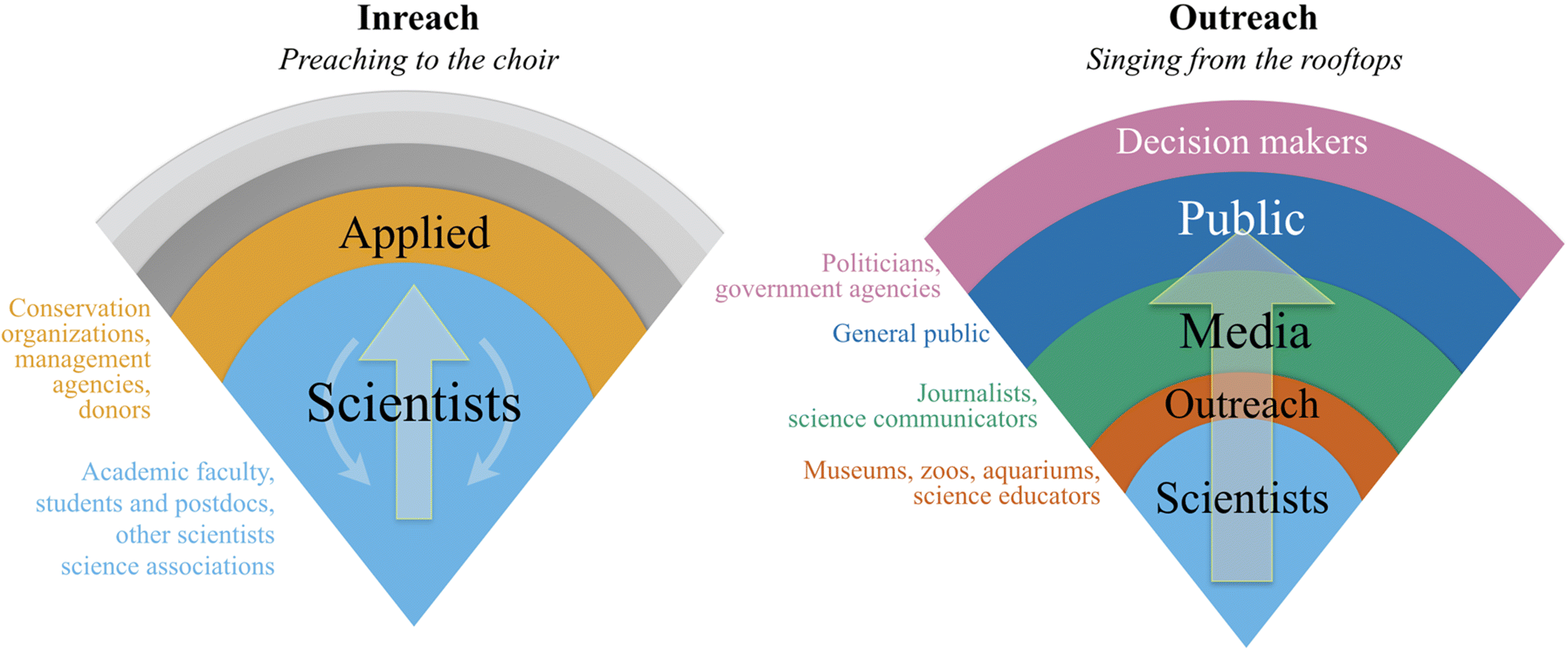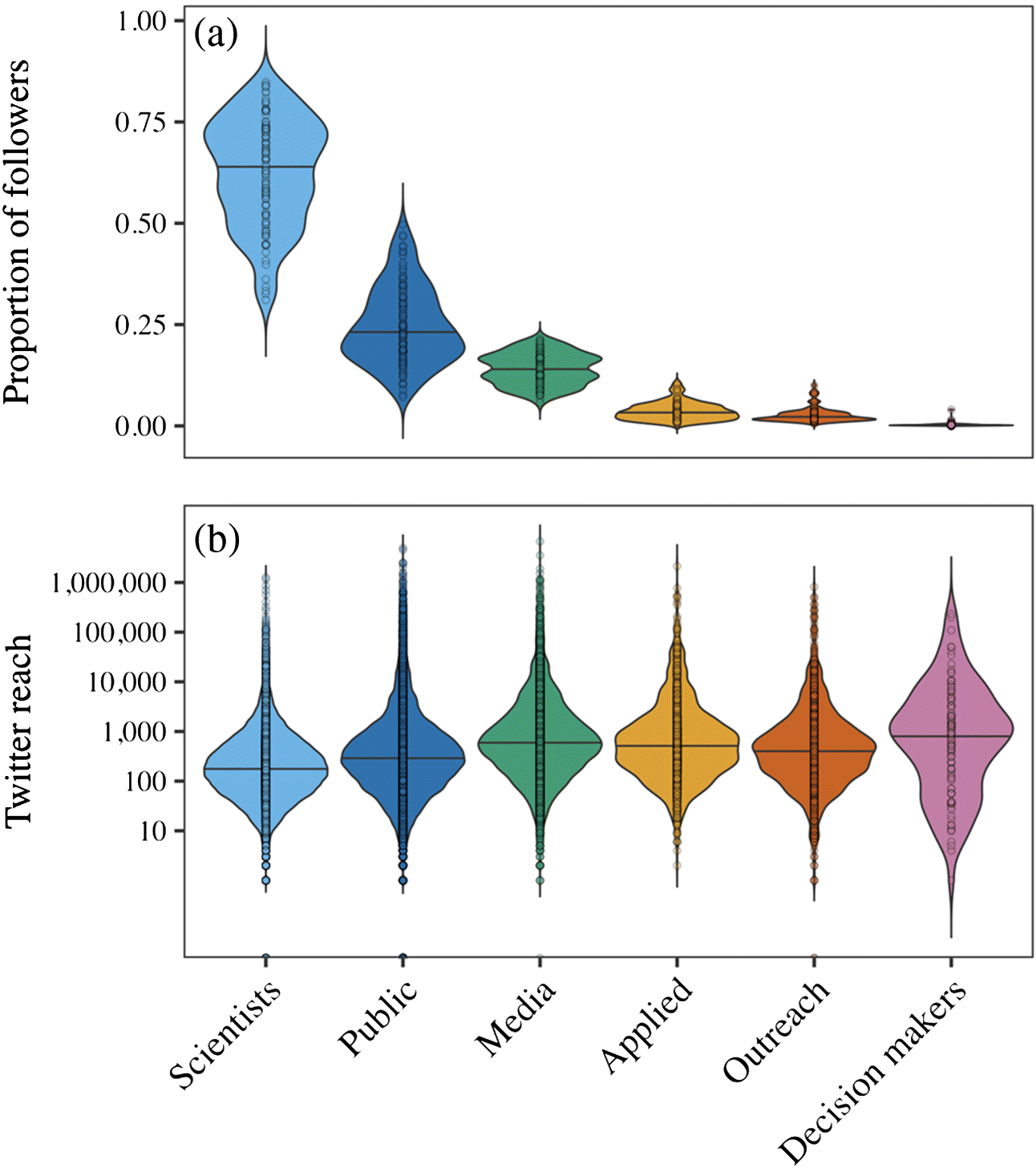Cited by
1. Mind the gap: questioning the existence of a ‘knowledge deficit’ in conservation social media message evaluation by scientist, science-trained, and general public audience groups
2. Can altmetric mentions reflect the quality of evidence? A study in Biomedical and Life Sciences
3. Communicating the interdependence of human, animal, and environmental health on X (formerly Twitter): Insights from the one health approach
4. Characterizing an online, science-based affinity space using topic modelling, diversity indices, and social network analysis
5. Who Are the Science Audiences? A Typology Study on Digital Scientific Audiences: Persona, Performance, and Public
6. Behind the lab coat: How scientists’ self-disclosure on Twitter influences source perceptions, tweet engagement, and scientific attitudes through social presence
7. Pesquisadores e Profissionais da Informação no Twitter (X)
8. Web-based science communication at Research Institute level: balancing dissemination, dialogue and promotion in a major Italian scientific institution
9. The effects of self-disclosure and gender on a climate scientist’s credibility and likability on social media
10. Health Risk Communication During COVID-19 Emergency in Italy: The Impact of Medical Experts’ Debate on Twitter
11. Is it time to get over the X? Assessing the global impact and future of social media conferences in animal behaviour
12. ORCID Profil Tamamlama ve Türkiye'deki Akademisyenlerin Dijital Kimliği
13. Scientists’ side of the microphone: An examination of agricultural and natural resources podcast guests’ experiences
14. What is the effect of posting video abstracts on journal article impact?
15. Controlled experiment finds no detectable citation bump from Twitter promotion
16. Future of Remote Sensing for Geohazards and Resource Monitoring
17. Benefits and Barriers of Using WhatsApp in Eye Health Communication in Deprived Settings in India
18. Faites de votre article un influenceur numérique
19. Twitter conference discussion sessions: How and why researchers engage in online discussions
20. Space Weather in the Popular Media, and the Opportunities the Upcoming Solar Maximum Brings
21. Relating popularity on Twitter and Linkedin to bibliometric indicators of visibility and interconnectedness: an analysis of 8512 applied researchers in Germany
22. Science communication on Twitter: Measuring indicators of engagement and their links to user interaction in communication scholars’ Tweet content
23. Controlled experiment finds no detectable citation bump from Twitter promotion
24. The #Scicomm Phenomenon: Using and Analysing Big Data to Track Science Communication on Czech Research Institutional Websites
25. CIENTISTAS DA INFORMAÇÃO NO TWITTER
26. Science communication in experimental biology: experiences and recommendations
27. Post or perish? Social media strategies for disseminating orthopedic research
28. Neurofeedback on twitter: Evaluation of the scientific credibility and communication about the technique
29. Could the altmetrics wave bring a flood of confusion for anatomists?
30. Turning your paper into a digital influencer
31. Forms and functions of intertextuality in academic tweets composed by research groups
32. Birds of feather flock together: A longitudinal study of a social media outreach effort
33. Multimodal practices of research groups in Twitter: An analysis of stance and engagement
34. Scientists as Influencers: The Role of Source Identity, Self-Disclosure, and Anti-Intellectualism in Science Communication on Social Media
35. Universidades y redes sociales: De la divulgación científica a la autopromoción
36. ¿Tiene género la divulgación científica?
37. Editing the Final Draft
38. Using Twitter for Public Dissemination and Engagement with Science: Metadiscourse on the Twitter Accounts of Scientific Organisations
39. Wissenschaftskommunikation und -PR im digitalen Zeitalter – Möglichkeiten sozialer Netzwerke für Forschende
40. Understanding researchers’ Twitter uptake, activity and popularity—an analysis of applied research in Germany
41. Twitter trends in #Parasitology determined by text mining and topic modelling
42. Characterizing Precision Nutrition Discourse on Twitter: Quantitative Content Analysis
43. Strategies for improving the communication of satellite-derived InSAR data for geohazards through the analysis of Twitter and online data portals
44. An HCI Research Agenda for Online Science Communication
45. Social Media in Transplantation: An Opportunity for Outreach, Research Promotion, and Enhancing Workforce Diversity
46. Ecosystem Services: A Social and Semantic Network Analysis of Public Opinion on Twitter
47. Characterizing Precision Nutrition Discourse on Twitter: Quantitative Content Analysis (Preprint)
48. Institutionalizing public engagement in research and innovation: Toward the construction of institutional entrepreneurial collectives
49. Effect of charismatic signaling in social media settings: Evidence from TED and Twitter
50. Engagement patterns with female and male scientists on Facebook
51. It's Beginning to Look a Lot like
#
25DaysofFishmas: Communicating Freshwater Biodiversity Using Social Media
52. The (R)evolution of Social Media in Oncology: Engage, Enlighten, and Encourage
53. Who tweets climate change papers? investigating publics of research through users’ descriptions
54. Social TV and the WWE: Exploring the fan-to-brand relationship in a highly engaged, live-viewing, interactive online space
55. An inclusive venue to discuss behavioural biology research: the first global Animal Behaviour Twitter Conference
56. Identifying widely disseminated scientific papers on social media
57. Introducing the EMPIRE Index: A novel, value-based metric framework to measure the impact of medical publications
58. ‘Give the Money Where it’s Due’: The Impact of Knowledge-Sharing via Social Media on the Reproduction of the Academic Labourer
59. Social Media Interaction as Informal Science Learning: a Comparison of Message Design in Two Niches
60. Make Your Science Go Viral: How to Maximize the Impact of Your Research
61. Socially Responsible Consumption and Marketing in Practice
62. Social Paleontology on Twitter: A Case Study of Topic Archetypes, Network Composition, and Structure
63. Retrospectively evidencing research impact using online data mining
64. Use of the Hashtag #DataSavesLives on Twitter: Exploratory and Thematic Analysis
65. Exploring TikTok as a promising platform for geoscience communication
66. Goodbye to “Rough Fish”: Paradigm Shift in the Conservation of Native Fishes
67. Enhancing engagement beyond the conference walls: analysis of Twitter use at #ICPIC2019 infection prevention and control conference
68. Fewer and Later: Women as Experts in TED Talks about COVID-19
69. Credibility of scientific information on social media: Variation by platform, genre and presence of formal credibility cues
70. Poetry as a Tool For Outreach in Quaternary Science: Examples From the 20th INQUA Congress
71. Understanding academics online
72. Themes, communities and influencers of online probiotics chatter: A retrospective analysis from 2009-2017
73. Twitter conferences as a low‐carbon, far‐reaching and inclusive way of communicating research in ornithology and ecology
74. On the Coercive Nature of Research Impact Metrics: The Case Study of Altmetrics and Science Communication
75. Social media for clinical neurophysiology
76. Delivering eye health education to deprived communities in India through a social media‐based innovation
77. Introducing the EMPIRE Index: A novel, value-based metric framework to measure the impact of medical publications
78. Innovation via social media – The importance of Twitter to science
79. How to get your feet wet in public engagement: Perspectives from freshwater scientists
80. March Mammal Madness and the power of narrative in science outreach
81. Self-promotion and the need to be first in science
82. Expert communication on Twitter: Comparing economists’ and scientists’ social networks, topics and communicative styles
83. A Social Media Campaign (#datasaveslives) to Promote the Benefits of Using Health Data for Research Purposes: Mixed Methods Analysis
84. Editorial: Geoscience communication – planning to make it publishable
86. Going rogue: what scientists can learn about Twitter communication from “alt” government accounts
87. Where are all the anthelmintics? Challenges and opportunities on the path to new anthelmintics
88. Five Organizational Features That Enable Successful Interdisciplinary Marine Research
89. Using interpersonal communication strategies to encourage science conversations on social media
90. The impact of preprints in Library and Information Science: an analysis of citations, usage and social attention indicators
91. Public Scholarship and CSCW
92. Social Media: A New Tool for Scientific Engagement
93. Quantifying and contextualizing the impact of bioRxiv preprints through automated social media audience segmentation
94. What the hashtag? Using twitter and podcasting to extend your scientific reach
95. Broadcasting Ourselves: Opportunities for Researchers to Share Their Work Through Online Video
96. Five Lessons from COVID-19 for Advancing Climate Change Mitigation
97. “People are reading your work,” scholarly identity and social networking sites
98. Who is Not Afraid of Richard Dawkins? Using Google Trends to Assess the Reach of Influential Atheists across Canadian Secular Groups
99. Altmetrics analysis of Archivos de Bronconeumología from 2014 to 2018
100. Análisis de las métricas alternativas de Archivos de Bronconeumología durante el periodo 2014-2018
101. Disseminating Research News in HCI
102. Using social media to promote academic research: Identifying the benefits of twitter for sharing academic work
103. #SoMe4Surgery: from inception to impact
104. Please, Don’t Kill It with Fire: An Exploration of Entomological Science Communication
105. Quantifying and contextualizing the impact of bioRxiv preprints through automated social media audience segmentation
106. Does really no one care? Analyzing the public engagement of communication scientists on Twitter
107. A Comparison of the Citing, Publishing, and Tweeting Activity of Scholars on Web of Science
108. How scientists and physicians use Twitter during a medical congress
109. Improving Climate-Change Literacy and Science Communication Through Smart Device Apps
110. Adoption of social media for scientific communication by PhD students
111. Social media to engage, communicate and interact
112. A Social Media Campaign (#datasaveslives) to Promote the Benefits of Using Health Data for Research Purposes: Mixed Methods Analysis (Preprint)
113. Of scientists and tweets
114. Geoscience analysis on Twitter
115. The reward and risk of social media for academics
116. Challenges and opportunities for biogeography—What can we still learn from von Humboldt?
117. Scientific Twitter: The flow of paleontological communication across a topic network
118. Measuring the Impact of Research Using Conventional and Alternative Metrics
119. Stepping Out of the Ivory Tower for Ocean Literacy
120. Getting to Know Science Tweeters: A Pilot Analysis of South African Twitter Users Tweeting about Research Articles
121. The Psychology of Connectivity: Follower Counts and Identity
122. Using Art To Communicate Chemistry
123. Developing a social media strategy for R&D in energy efficiency – a case study in progress
124. Inter-disciplinary, multi-scale science to support society to adapt under global change
125. Science podcasts: analysis of global production and output from 2004 to 2018
126. Taking a
Breath of the Wild
: are geoscientists more effective than non-geoscientists in determining whether video game world landscapes are realistic?
127. Likes, comments, and shares of marine organism imagery on Facebook
128. Public engagement opportunities for the indoor air community
129. Enhancing Climate Change Research With Open Science
130. Geoscientists online
131. Building and Sustaining Diverse Functioning Networks Using Social Media and Digital Platforms to Improve Diversity and Inclusivity
132. Science Podcasts: Analysis of Global Production and Output From 2004 to 2018
133. In the Search of Quality Influence on a Small Scale – Micro-influencers Discovery




